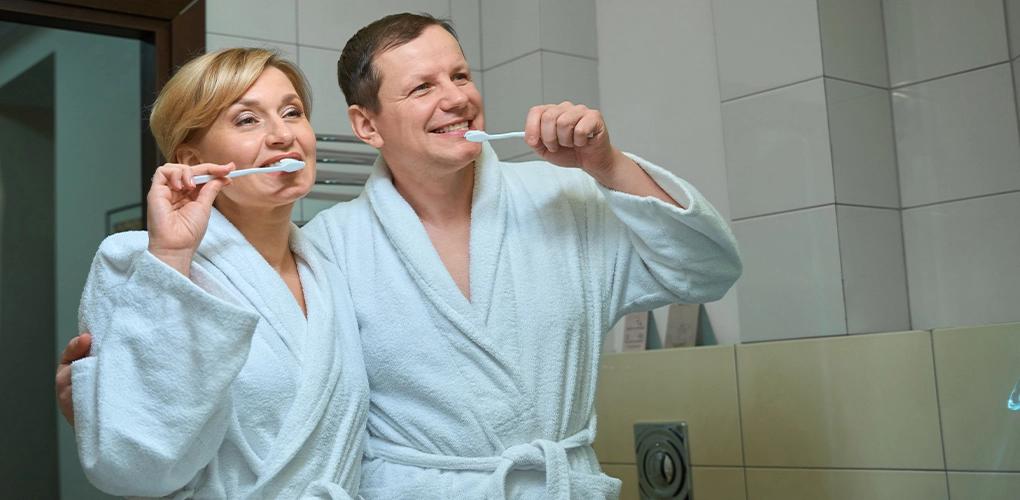Tooth Brushing
Tooth brushing with fluoride toothpaste twice daily is recommended by American Dental Association (ADA) to remove plaque and food debris. It helps to prevent tooth decay and prevents gum diseases. Brushing helps in removing bacteria that cause bad breath and give a feeling of freshness.
Plaque is a sticky white film that appears on teeth after having a meal. Plaque contains bacteria that produces acids. This acid and bacteria attack tooth enamel (outer and the hardest layer of teeth). If a person ignores brushing or uses improper tooth brushing technique, it will cause tooth decay and cavities over time.
Home remedies or prevention tips over tooth brushing cannot preserve teeth from damage. These remedies can work as an adjunct therapy with tooth brushing to protect teeth from decay.
Importance of Tooth Brushing
Brushing twice daily is essential to maintain oral hygiene. Periodontal diseases might develop if a person refuses to brush their teeth for a certain time. Brushing correctly ensures that plaque (main cause of gum disease and tooth decay) is removed and prevents it from accumulation below gumline.
Benefits of Tooth Brushing
- Fresh breath
- Prevent dental caries
- Keep gums healthy
- Reduce tooth staining
- Reduce risk of diabetes
- Lower the chances of heart problems
Consequences of Not Brushing
Ignoring brushing for long term can cause negative consequences like:
- Tooth decay
- Gum diseases
- Halitosis
- Abscess
- Plaque and tartar buildup
Some health-related consequences might also occur as:
- Kidney issues
- Heart problems
- Diabetes
- Pneumonia
- Stomach problem
Tooth Brushing Techniques
Following are the ADA recommended brushing technique:
- Wash your brush and take pea-sized toothpaste.
- Place your brush at a 45° angle to gums.
- Use short back and forth strokes for chewing surfaces of teeth.
- Use circular movements for inner and outer surfaces of teeth.
- Place brush vertically and slide down on teeth surfaces to clean front teeth.
- At last brush tongue and cheeks softly.
- Rinse mouth thoroughly with water.
Brushing for Kids
Initiate healthy habits from an early age. It is recommended to introduce brushing in your child from two years. Use soft-bristle kids’ toothbrush and kids’ toothpaste in the beginning and make it a fun activity. Always be there when your child starts brushing and make sure he/she rinses thoroughly after brushing.
Electric vs. Manual Toothbrush
Electric and manual toothbrushes are both effective. However, electric toothbrushes are found to have more benefits than manual brushes. The bristles of an electric toothbrush rotate or vibrate to scrape plaque from gums and teeth. Moreover, electric toothbrushes are effective for handicapped patients and for those who wear orthodontic appliances.
Choosing the Right Toothbrush
Types of Toothbrush Bristles
Looking for bristles is important while selecting a toothbrush for your mouth. You can make the most of your oral care with the right toothbrush. Toothbrush bristles can be classified on the basis of their stiffness as soft, medium, and hard bristles
- Soft-bristle brush: It is recommended by most of the dentists. It is useful for both children and adults. They are gentle on gums and teeth and seamlessly remove plaque and tartar. It does not cause any harm to oral tissues.
- Medium-bristle brush: Medium bristle brushes are good for healthy cleaning. Its bristles are a little firmer than soft bristle brush. If you are using medium bristle brush aggressively on gums, it can cause bleeding problem. Apply controlled force with the right technique while using medium bristle brush to achieve the best cleaning results.
- Hard-bristle brush: Hard bristle brushes are not used for everyday dental care. Hard bristle brushes can damage gum tissues and can erode teeth enamel. Hard bristle brushes are mostly used to clean dentures.
Toothbrush Features to Look for
- Look for soft or medium-bristle brush
- Small head size brush
- Handle with easy grip
- Look for ADA seal
How Often to Replace a Toothbrush
It is recommended to replace your toothbrush after every three months. Using the same toothbrush after three months is of no use because its bristles lose their effectiveness after three months. As the time passes brush bristles get frayed, which means they can no longer remove plaque and bacteria from teeth.
Common Tooth Brushing Mistakes
- Overbrushing
- Not brushing for long enough (2 minutes/day)
- Brushing in morning only
- Improper technique
- Rinsing after brushing (toothpaste should not be removed from teeth after brushing)
- Aggressive brushing
- Skipping tongue

